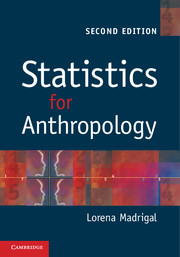Book contents
- Frontmatter
- Contents
- List of partial statistical tables
- Preface
- 1 Introduction to statistics and simple descriptive statistics
- 2 The first step in data analysis
- 3 Probability and statistics
- 4 Hypothesis testing and estimation
- 5 The difference between two means
- 6 The analysis of variance (ANOVA)
- 7 Non-parametric tests for the comparison of samples
- 8 The analysis of frequencies
- 9 Correlation analysis
- 10 Simple linear regression
- 11 Advanced topics in regression analysis
- References
- Index
8 - The analysis of frequencies
Published online by Cambridge University Press: 05 June 2012
- Frontmatter
- Contents
- List of partial statistical tables
- Preface
- 1 Introduction to statistics and simple descriptive statistics
- 2 The first step in data analysis
- 3 Probability and statistics
- 4 Hypothesis testing and estimation
- 5 The difference between two means
- 6 The analysis of variance (ANOVA)
- 7 Non-parametric tests for the comparison of samples
- 8 The analysis of frequencies
- 9 Correlation analysis
- 10 Simple linear regression
- 11 Advanced topics in regression analysis
- References
- Index
Summary
This chapter presents a departure from the statistical tests covered so far: we do not deal with quantitative variables such as fertility, prestige ranks, height, weight, etc., within a sample or among several samples. Instead we deal with frequencies of occurrences or events. We work with variables which have a few possible outcomes, and we are concerned with the number of individuals who have each of the outcomes (where a is the number of outcomes). Often-used anthropological frequency data are gene frequencies, the frequencies of males and females, the frequencies of different ethnic groups, the frequencies of different pottery styles in archaeological sites, etc.
The X2 test for goodness-of-fit
In this section we discuss the well-known and widely used chi-square test (X2), applied as a goodness-of-fit test and as a test for independence of two variables. Not only is the X2 test widely used in anthropology, but unfortunately it has also been widely misused. The most common error about the X2 test is its own name: it is frequently referred to as χ2, which is the parametric notation for a theoretical frequency distribution against which the statistic computed from the sample (X2) should be compared. Therefore, the test statistic is X2, while the theoretical distribution is χ2. In addition, a correction which must be applied to small data sets is also discussed.
- Type
- Chapter
- Information
- Statistics for Anthropology , pp. 166 - 192Publisher: Cambridge University PressPrint publication year: 2012



